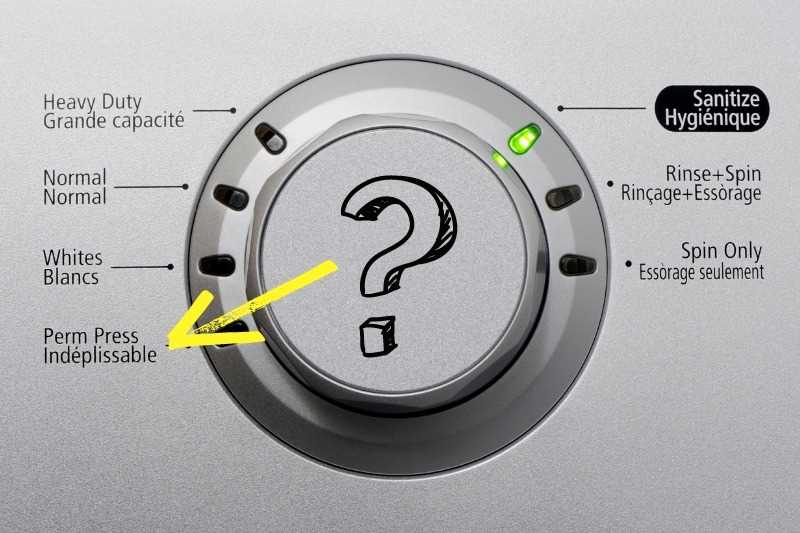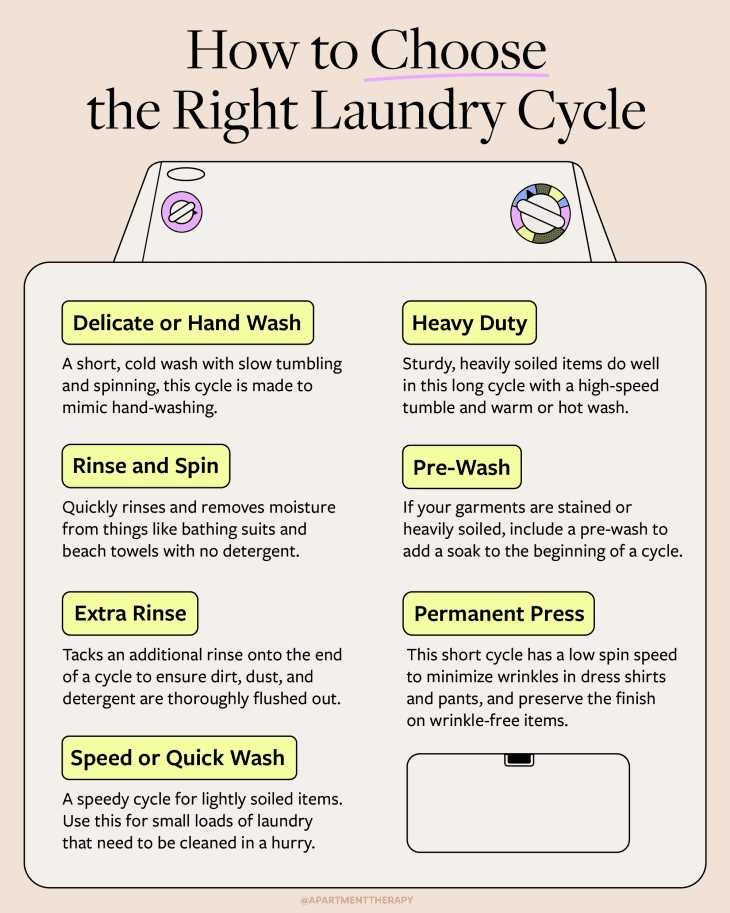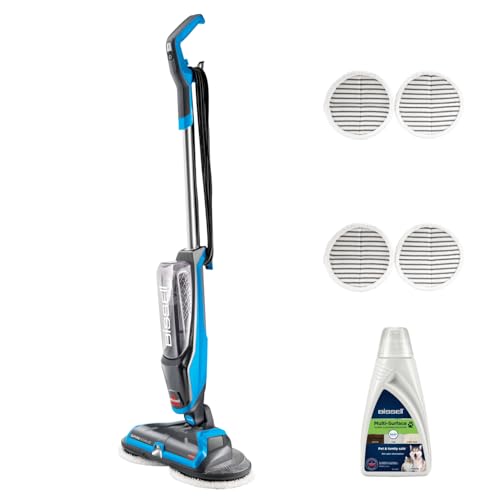




When it comes to doing laundry, understanding the different cycles on your washing machine can be quite confusing. Should you choose the permanent press cycle or the delicate cycle? What’s the difference between them? In this guide, we break it down for you, explaining the characteristics of each cycle and when it’s best to use them.
The permanent press cycle is designed for garments that are wrinkle-resistant or made from synthetic materials. These fabrics are more durable and can withstand higher heat and agitation levels. When you select the permanent press cycle, the washing machine will use a combination of warm water, a low- or medium-speed spin, and gentle agitation to clean and remove wrinkles from your clothes.
On the other hand, the delicate cycle is specifically designed for fragile fabrics, such as silk, lace, or cashmere. These fabrics require extra care to prevent damage. When you choose the delicate cycle, the washing machine uses cold water, a slow-speed spin, and minimal agitation to gently clean your delicate items without causing any harm.
In summary, the main difference between the permanent press and delicate cycle lies in the fabrics they are best suited for and the level of heat, agitation, and spin speed they use. The permanent press cycle is ideal for wrinkle-resistant and synthetic fabrics, while the delicate cycle is perfect for delicate and fragile fabrics that require extra care. Understanding these differences will help you choose the right cycle for your laundry and keep your clothes in great condition for longer.
Permanent Press vs. Delicate Cycle – What’s the Difference?
When it comes to doing laundry, it’s important to know the different washing cycles available on your washing machine. Two common cycles are the Permanent Press and Delicate cycles. Each cycle is designed to handle different types of fabrics and to ensure that your clothes are cleaned properly without getting damaged. Let’s take a closer look at the differences between these two cycles.
Permanent Press Cycle

The Permanent Press cycle is suitable for everyday clothes made from synthetic fabrics, like polyester, or a blend of synthetic and natural fibers. This cycle uses warm water and a fast agitation speed to remove dirt and stains from your clothes. It also includes a cool-down rinse and a slower spin speed to reduce wrinkles in the fabric. This cycle is ideal for items that require a more thorough cleaning, such as shirts, pants, and bed linens.
However, it’s important to note that the Permanent Press cycle may not be suitable for delicate items or fabrics that require special care. Delicate fabrics, like silk or lace, can be damaged by the strong agitation and high heat used in the Permanent Press cycle. For these items, it’s best to use the Delicate cycle.
Delicate Cycle

The Delicate cycle is designed for fragile or delicate fabrics that cannot withstand the same level of agitation or heat as other fabrics. This cycle typically uses cooler water temperatures and a slower, gentler agitation speed to protect the fabrics from damage. It also includes a shorter spin cycle to prevent excessive wrinkling.
Delicate fabrics include silk, lace, wool, cashmere, and other materials that require more delicate care. The Delicate cycle is also suitable for items that have embellishments, like sequins or beading, which can be easily damaged by rough handling or excessive agitation.
When using the Delicate cycle, it’s important to follow the garment care instructions and use a gentle, mild detergent. It’s also a good idea to place delicate items in a mesh laundry bag to provide an extra layer of protection during the wash cycle.
Conclusion
Knowing the differences between the Permanent Press and Delicate cycles can help you properly care for your clothes and ensure that they are cleaned without damage. Use the Permanent Press cycle for everyday synthetic fabrics, and reserve the Delicate cycle for delicate and fragile fabrics. Always check the care instructions on your clothing labels and follow them accordingly to maintain the quality and longevity of your clothes.
Understanding the Permanent Press Cycle
The permanent press cycle is a common setting on modern washing machines that is designed to take care of most types of everyday clothing, such as jeans, shirts, and pants. It is a versatile cycle that is specifically designed to balance cleaning and garment care.
How does the Permanent Press Cycle work?
The permanent press cycle works by using a combination of warm or cool water, a gentle agitation pattern, and a slow spin cycle to clean your clothes while minimizing the risk of wrinkles and shrinking. Here’s how it works:
- Water temperature: The permanent press cycle typically uses warm or cool water instead of hot water to prevent shrinking or damage to delicate fabrics.
- Agitation pattern: The washing machine uses a gentle tumbling motion to clean your clothes, rather than the more aggressive agitation used in the regular cycle. This helps to reduce the risk of creases and wrinkles.
- Slow spin cycle: After the washing cycle is complete, the machine will perform a slow spin to remove excess water from the clothes. This slower speed helps to prevent clothes from becoming tangled and wrinkled.
When should you use the Permanent Press Cycle?
The permanent press cycle is suitable for most types of everyday clothing, including shirts, blouses, pants, and synthetic fabrics. It is especially useful for clothes that are prone to wrinkling, such as cotton or linen garments.
- Shirts and blouses
- Pants and jeans
- Synthetic fabrics (polyester, nylon, etc.)
- Cotton and linen garments
Tips for using the Permanent Press Cycle
To get the best results with the permanent press cycle, here are a few tips to keep in mind:
- Make sure to use the appropriate amount of detergent for your load size.
- Separate your clothing by color to prevent dye transfer.
- Don’t overload the machine, as this can lead to poor cleaning and increased wrinkling.
- Remove your clothes from the machine promptly after the cycle is completed to minimize wrinkling.
By understanding how the permanent press cycle works and when to use it, you can effectively clean and care for your everyday clothing while minimizing the risk of wrinkles and damage.
Exploring the Delicate Cycle

What is the delicate cycle?
The delicate cycle is a setting on washing machines that is specifically designed for washing delicate fabrics and garments. It uses a slower agitation and spin cycle to prevent damage to the items being washed.
When should you use the delicate cycle?

The delicate cycle is ideal for washing fabrics that require gentle treatment, such as silk, lace, chiffon, and other delicate materials. It is also suitable for clothing with embellishments like sequins or beads, as well as items with embroidery or delicate stitching.
You should also use the delicate cycle for clothing with washing instructions that specifically recommend it, as well as for items that are prone to shrinkage or damage in a regular cycle.
How to use the delicate cycle
Using the delicate cycle is simple. First, sort your laundry to separate delicate items from regular items. Place the delicate items in the washing machine, making sure not to overload the machine.
Next, add a gentle detergent that is specifically formulated for delicate fabrics. Avoid using bleach or fabric softeners, as they can damage delicate materials.
Select the delicate cycle on your machine, along with any additional settings that may be available. These could include temperature options or length of the cycle.
Once the cycle is complete, remove your delicate items from the machine promptly to prevent them from wrinkling. Gently reshape and lay them flat to dry, or use a drying rack if necessary. Avoid using a dryer for delicate items, as the heat can cause damage.
Tips for washing delicate items

- Always read and follow the care instructions on each garment to ensure proper washing.
- Consider using a mesh laundry bag to further protect delicate items from damage.
- If you are unsure about whether an item should be washed on the delicate cycle, err on the side of caution and choose the delicate cycle.
- Hand washing delicate items is also an option if you prefer to have more control over the process.
- Hang dry delicate items whenever possible to avoid shrinkage and damage from heat.
By using the delicate cycle and following these tips, you can keep your delicate garments looking their best and extend their lifespan.
When to Use the Permanent Press Cycle

The permanent press cycle is a setting on washing machines that is designed to be gentler on clothes than the regular cycle. It is particularly useful for clothing items made from delicate materials or that have specific care instructions. Here are some situations where you might want to use the permanent press cycle:
1. Delicate Fabrics
- Silk, satin, lace, and other delicate fabrics should be washed on the permanent press cycle to avoid damage.
- The gentle agitation and slower spin speed of this cycle help to minimize the risk of tearing or stretching these delicate materials.
2. Synthetic Fabrics
- Clothes made from synthetic fabrics like polyester or nylon can also be safely washed on the permanent press cycle.
- This cycle helps to prevent static cling and reduce wrinkles in these types of fabrics.
3. Mixed Loads
- If you have a load of laundry that consists of both delicate and more durable items, using the permanent press cycle can be a good compromise.
- This cycle is typically shorter than the delicate cycle, but still provides enough gentle care for the delicate items in the load.
4. Wrinkle-Prone Clothing
- Permanent press cycle is ideal for clothing that tends to wrinkle easily.
- This cycle includes a cool-down period at the end of the wash cycle, which helps to reduce wrinkles and minimize the need for ironing.
Overall, the permanent press cycle is a versatile option that can be used for a variety of garments and fabrics. It provides a balance between gently cleaning and preventing wrinkles, making it a popular choice for many laundry tasks.
When to Use the Delicate Cycle
The delicate cycle is specifically designed for delicate fabrics and items that require gentle handling during the washing process. Here are some situations when you should consider using the delicate cycle:
- Delicate Fabrics: The delicate cycle is ideal for washing fabrics such as silk, lace, chiffon, and satin. These fabrics are delicate and can easily get damaged or lose their shape if washed using a regular or permanent press cycle.
- Underwear and Lingerie: Delicate undergarments, such as bras, panties, and stockings, should be washed on the delicate cycle to prevent them from excessive stretching or snagging.
- Embroidered or Beaded Items: Clothes or accessories with intricate embroidery or delicate beading should be washed on the delicate cycle to avoid damaging or loosening the embellishments.
- Sheer or Thin Fabrics: Sheer or thin fabrics, like organza or voile, can easily tear or get pulled during a regular wash cycle. The delicate cycle provides a gentler wash action to prevent damage to these delicate fabrics.
- Items with Special Care Instructions: Some clothing or household items may come with specific care instructions that recommend using the delicate cycle. These instructions should be followed to ensure the longevity and quality of the item.
To protect your delicate items and extend their lifespan, it is crucial to follow the manufacturer’s instructions and use the delicate cycle whenever appropriate. Additionally, always separate dark and light colours, and avoid washing heavily soiled items together with delicate ones.
Tips for Properly Caring for Your Clothes
- Read the Care Labels: Always check the care labels on your clothes before washing them. They provide important instructions on the appropriate washing method.
- Sort Your Laundry: Sort your laundry by color and fabric type. Separate whites, darks, and bright colors to prevent color bleeding and fading. Additionally, delicate fabrics should be washed separately.
- Use the Right Water Temperature: Pay attention to the recommended water temperature indicated on the care label. Hot water can shrink and fade certain fabrics, while cold water may not effectively remove stains or kill bacteria.
- Select the Right Cycle: Choose the appropriate cycle for your clothes. Use the delicate cycle for fragile or lightweight fabrics, and the permanent press cycle for wrinkle-resistant and everyday clothes.
- Pre-treat Stains: Treat stains as soon as possible to increase the chances of successful removal. Use stain-removing products or household remedies like vinegar or baking soda before washing.
- Use the Correct Amount of Detergent: Follow the recommended dosage of detergent for your load size. Using too much detergent can leave residue on your clothes, while using too little may not effectively clean them.
- Avoid Overloading the Washer: Overloading the washer can result in poor cleaning performance and excessive wear on your clothes. Leave enough space in the machine for proper agitation and rinsing.
- Turn Clothes Inside Out: Turn delicate or heavily printed clothes inside out before washing. This helps minimize friction and prevent damage to the fabric or design.
- Air Dry or Tumble Dry Low: When drying your clothes, check the care label for the recommended drying method. Air drying is the gentlest option, while low heat in the dryer can help prevent shrinkage or damage.
- Iron with Caution: Iron your clothes on the appropriate setting indicated on the care label. Some fabrics require low heat or steam, while others may need higher heat to remove wrinkles.
- Store Clothes Properly: Folding or hanging your clothes properly can help maintain their shape and prevent wrinkles. Avoid overcrowding your closet to allow air circulation and prevent clothing from becoming musty.
FAQ
What is the difference between the permanent press cycle and the delicate cycle?
The permanent press cycle is designed for durable fabrics that are resistant to wrinkles, such as cotton or polyester, while the delicate cycle is meant for more delicate fabrics, like silk or lace. The permanent press cycle uses higher heat and a faster spin to remove wrinkles, while the delicate cycle uses lower heat and a slower spin to prevent damage to delicate fabrics.
Can I use the permanent press cycle for all types of fabrics?
No, the permanent press cycle is not suitable for all types of fabrics. It is best for durable fabrics that can withstand higher heat and a faster spin. Delicate fabrics may shrink or become damaged if washed on the permanent press cycle. It is always recommended to check the care label on your clothing for the recommended washing instructions.
What happens if I use the delicate cycle for durable fabrics?
If you use the delicate cycle for durable fabrics, they may not get fully clean and may still have wrinkles. The delicate cycle uses lower heat and a slower spin, which may not be enough to remove tough stains or wrinkles from durable fabrics. It is best to use the permanent press cycle for these types of fabrics to ensure they are properly cleaned and wrinkle-free.
Can I mix delicate fabrics with durable fabrics in one load?
It is generally not recommended to mix delicate fabrics with durable fabrics in one load. Delicate fabrics require gentler handling and lower heat, while durable fabrics may need higher heat and a faster spin. Mixing them together may result in damage to the delicate fabrics or insufficient cleaning of the durable fabrics. It is best to wash them separately to ensure the best care for each type of fabric.
How do I know which cycle to use for my clothes?
You can refer to the care label on your clothing for the recommended washing instructions. Most clothing manufacturers provide guidelines on the care labels that specify the appropriate cycle to use for different fabrics. If you are unsure, you can also do a quick online search or consult the washing machine’s user manual for guidance on which cycle to use for specific types of fabric.
What is the difference between the permanent press cycle and the delicate cycle?
The permanent press cycle is designed for clothing items that are made of synthetic materials or have wrinkle-resistant properties. It uses a combination of warm wash and cool rinse, along with a slower spin cycle, to reduce wrinkling. On the other hand, the delicate cycle is meant for fragile fabrics such as silk, lace, or wool. It uses cool water, gentle agitation, and a slower spin speed to prevent damage to these delicate items.
Can I use the permanent press cycle for all types of clothing?
The permanent press cycle is suitable for most everyday clothing items, especially those made of synthetic materials or have wrinkle-resistant properties. However, it may not be suitable for very delicate fabrics or items with specific care instructions. It’s always best to check the care label on your clothing to determine the recommended cycle.













